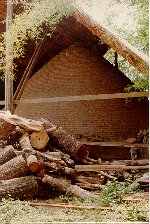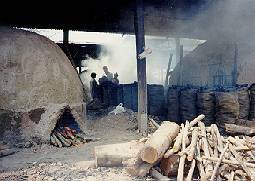

Wood Energy Conversion
Types of conversion processes - Charcoal production - Briquetting - RWEDP activities - Further reading - Other issues in wood energy
Before energy can be used for end-use activities, it often has to be converted from its primary form into a form that is more convenient for transport and use. Also wood is converted into other forms for energy purposes, such as charcoal, briquettes, gas, ethanol and electricity. Wood energy conversion technologies range from simple, traditional processes such as charcoal production in earth mounds to modern, highly efficient processes, such as dendro power and co-generation.
Types of Conversion Processes
The main processes of woodfuel conversion are listed below:
| Drying and resizing: wood is cut and split in sizes that are easy to transport, and it is dried before being burned or used as raw material in one of the following processes. | |
| Carbonization: the process of burning wood or biomass in the absence of air breaks it down into liquids, gases and charcoal; | |
| Gasification: this is the process in which solid biomass fuels (e.g. wood, charcoal) are broken down by the use of heat to produce a combustible gas, known as producer gas; | |
| Densification: to overcome the bulky nature, low thermal efficiency and smoke emission of wood and agriculture residues, these can be processed to produce smokeless briquettes. The residues may first be carbonized and then briquetted with or without binders, or the other way round; | |
| Liquid fuel production (e.g. ethanol/alcohol) by hydrolysis, anaerobic digestion,etc.: liquid fuels can be produced from several biomass types such as wood pulp residues (black liquor), sugarcane and cassava; | |
| Combustion: biomass fuels can also be used for power generation and/or heat production by direct combustion, either in its primary form or after one or more of the above mentioned transformation processes; |
Generally, biomass fuels are consumed by direct combustion in their primary form after drying and resizing, or in the form of charcoal. New conversion technologies such as gasification and anaerobic digestion have been developed to provide alternatives and to match biomass resources with modern end-use devices. However, as of yet these technologies are not widely used, so also in the near future wood energy conversion will consist mainly of resizing, drying and charcoal production.
Nevertheless, in recent years there has been increasing use of wood and other biomass for energy conversion in modern applications, such as combined heat and power generation (CHP) and co-generation.
Charcoal Production
 Most charcoal is produced from wood, but other sources may be coconut shells and crop residues. Charcoal is produced in kilns by a process called pyrolysis, i.e. breaking down the chemical structure of wood under high temperature in the absence of air. During the process, first the water is driven from the wood (drying), and then the pyrolysis starts when the temperature in the kiln is high enough. When the pyrolysis is complete, the kiln gradually cools down, after which the charcoal can be removed from the kiln. Because some of the wood is burned to drive off the water, dry wood produces better charcoal at a higher efficiency. Typically, around two-third of the energy is lost in the process, but charcoal has advantages over fuelwood like stoves with higher efficiency, higher convenience and easier distribution.
Most charcoal is produced from wood, but other sources may be coconut shells and crop residues. Charcoal is produced in kilns by a process called pyrolysis, i.e. breaking down the chemical structure of wood under high temperature in the absence of air. During the process, first the water is driven from the wood (drying), and then the pyrolysis starts when the temperature in the kiln is high enough. When the pyrolysis is complete, the kiln gradually cools down, after which the charcoal can be removed from the kiln. Because some of the wood is burned to drive off the water, dry wood produces better charcoal at a higher efficiency. Typically, around two-third of the energy is lost in the process, but charcoal has advantages over fuelwood like stoves with higher efficiency, higher convenience and easier distribution.
The oldest and probably still the most widely used method for charcoal production is the earth kiln. Two varieties exist, the earth pit kiln and the earth mound kiln. An earth pit kiln is constructed by first digging a small pit in the ground. Then the wood is placed in the pit and lit from the bottom, after which the pit is first covered with green leaves or metal sheets and then with earth to prevent complete burning of the wood. The earth mound kiln is built by covering a mound or pile of wood on the ground with earth. The mound is preferred over the pit where the soil is rocky, hard or shallow, or the water table is close to the surface. Mounds can also be built over a long period, by stacking gathered wood in position and allowing it to dry before covering and burning.
 Earth kilns can be made at minimal cost, and are often used near wood resources, since they can be made entirely from local materials. Earth kilns can be made in any size, with the duration of the process ranging from three days to two months. Gross variations in the quality of the charcoal can occur, because in one batch some of the wood is burned and some of the wood is only partly carbonised. Efficiencies are generally low, around 10-20% by weight and 20-40% in energy terms. The efficiency and the quality varies depending on the construction of the kiln (e.g. walls can be lined with rocks or bricks and external chimneys can be used), and the monitoring of the carbonisation process.
Earth kilns can be made at minimal cost, and are often used near wood resources, since they can be made entirely from local materials. Earth kilns can be made in any size, with the duration of the process ranging from three days to two months. Gross variations in the quality of the charcoal can occur, because in one batch some of the wood is burned and some of the wood is only partly carbonised. Efficiencies are generally low, around 10-20% by weight and 20-40% in energy terms. The efficiency and the quality varies depending on the construction of the kiln (e.g. walls can be lined with rocks or bricks and external chimneys can be used), and the monitoring of the carbonisation process.
Several other types of charcoal kilns have been developed, which generally have higher efficiencies but also require higher investments than the earth kiln. Two often-used types are fixed kilns made of mud, clay, bricks, and portable steel kilns. Fixed kilns usually have a beehive shape. Smaller beehives are usually made of mud and are not very durable. Larger beehives are made of bricks and have external chimneys. Beehive kilns have an opening for loading the wood and unloading the charcoal, which is closed after loading.
Portable steel kilns can be made from oil drums, and can be used both in horizontal and vertical position. They generally have a short lifetime. When used in the horizontal position, an opening is made in the side, through which the wood is loaded. For the vertical kiln the top is cut out and used as a lid.
Briquetting
Briquetting or densification is used to improve characteristics of materials for transport and use as energy source. Raw materials include sawdust, loose crop residues, and charcoal fines. The material is compacted under pressure, and depending on the material, the pressure, and the speed of densification, additional binders may be needed to bind the material. The two main briquetting technologies are the piston press and the screw press. In the piston press the material is punched into a die by a ram with a high pressure. In the screw press, the material is compacted continuously by a screw. With the screw press, generally briquettes of higher quality can be produced.
RWEDP activities
In cooperation with local organizations from Indonesia and Japan, RWEDP held a training of trainers on charcoal making to introduce new technologies. Participants came from selected organizations in countries where charcoal is an important fuel.
On briquetting, RWEDP published an overview of the main technologies and practices.
Further reading:
| Charcoal and its Socio-Economic Importance in Asia: Prospects for Promotion, Paper | |
| Biomass/Wood Energy Resources: Commercial Prospects for Wood-Based Technologies, Paper | |
| Biomass Briquetting: Technology and Practices, Field Document 46 | |
| International Workshop on Biomass Briquetting, RM 23 |
Comments, questions? webmaster@rwedp.org
© FAO-RWEDP, 1999